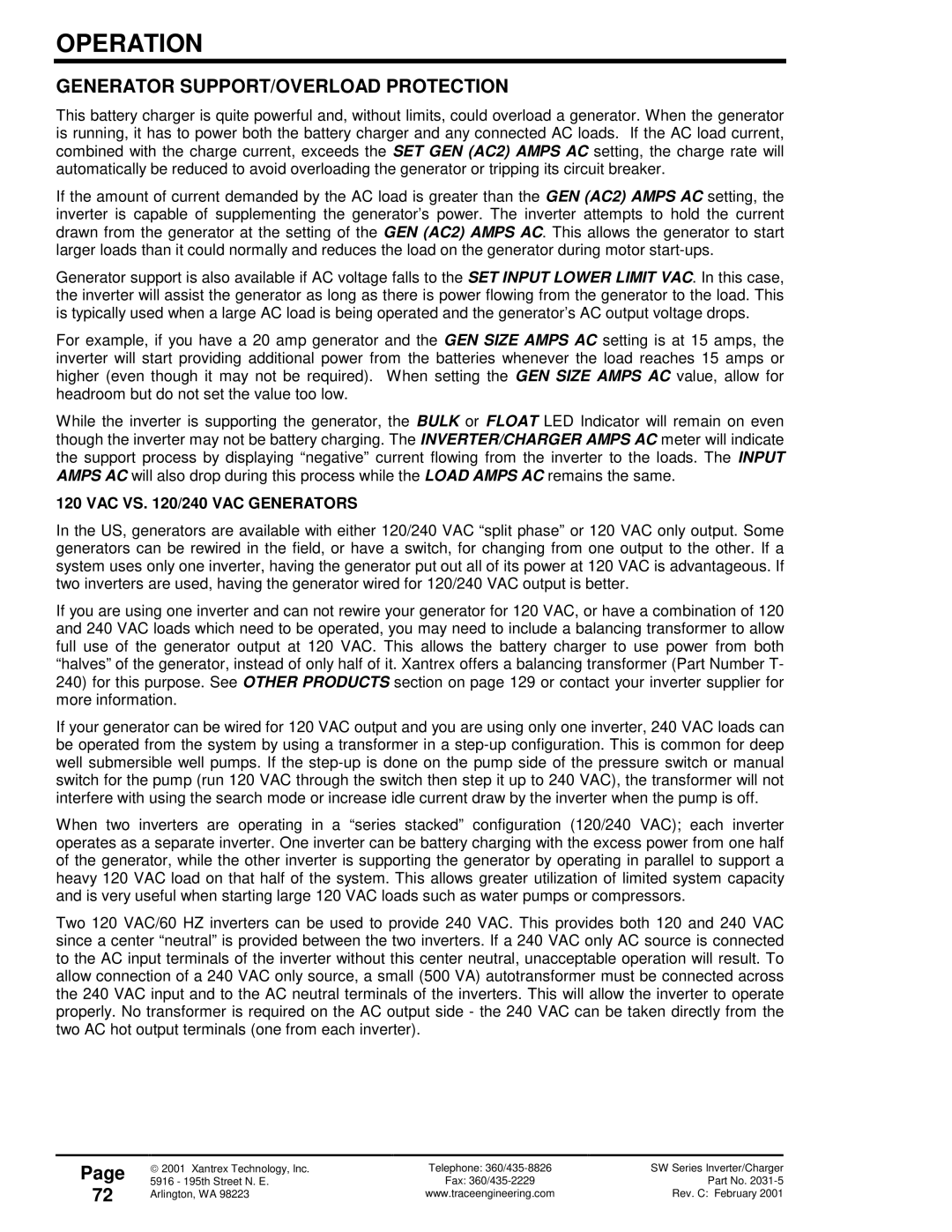
OPERATION
GENERATOR SUPPORT/OVERLOAD PROTECTION
This battery charger is quite powerful and, without limits, could overload a generator. When the generator is running, it has to power both the battery charger and any connected AC loads. If the AC load current, combined with the charge current, exceeds the SET GEN (AC2) AMPS AC setting, the charge rate will automatically be reduced to avoid overloading the generator or tripping its circuit breaker.
If the amount of current demanded by the AC load is greater than the GEN (AC2) AMPS AC setting, the inverter is capable of supplementing the generator’s power. The inverter attempts to hold the current drawn from the generator at the setting of the GEN (AC2) AMPS AC. This allows the generator to start larger loads than it could normally and reduces the load on the generator during motor
Generator support is also available if AC voltage falls to the SET INPUT LOWER LIMIT VAC. In this case, the inverter will assist the generator as long as there is power flowing from the generator to the load. This is typically used when a large AC load is being operated and the generator’s AC output voltage drops.
For example, if you have a 20 amp generator and the GEN SIZE AMPS AC setting is at 15 amps, the inverter will start providing additional power from the batteries whenever the load reaches 15 amps or higher (even though it may not be required). When setting the GEN SIZE AMPS AC value, allow for headroom but do not set the value too low.
While the inverter is supporting the generator, the BULK or FLOAT LED Indicator will remain on even though the inverter may not be battery charging. The INVERTER/CHARGER AMPS AC meter will indicate the support process by displaying “negative” current flowing from the inverter to the loads. The INPUT AMPS AC will also drop during this process while the LOAD AMPS AC remains the same.
120 VAC VS. 120/240 VAC GENERATORS
In the US, generators are available with either 120/240 VAC “split phase” or 120 VAC only output. Some generators can be rewired in the field, or have a switch, for changing from one output to the other. If a system uses only one inverter, having the generator put out all of its power at 120 VAC is advantageous. If two inverters are used, having the generator wired for 120/240 VAC output is better.
If you are using one inverter and can not rewire your generator for 120 VAC, or have a combination of 120 and 240 VAC loads which need to be operated, you may need to include a balancing transformer to allow full use of the generator output at 120 VAC. This allows the battery charger to use power from both “halves” of the generator, instead of only half of it. Xantrex offers a balancing transformer (Part Number T-
240)for this purpose. See OTHER PRODUCTS section on page 129 or contact your inverter supplier for more information.
If your generator can be wired for 120 VAC output and you are using only one inverter, 240 VAC loads can be operated from the system by using a transformer in a
When two inverters are operating in a “series stacked” configuration (120/240 VAC); each inverter operates as a separate inverter. One inverter can be battery charging with the excess power from one half of the generator, while the other inverter is supporting the generator by operating in parallel to support a heavy 120 VAC load on that half of the system. This allows greater utilization of limited system capacity and is very useful when starting large 120 VAC loads such as water pumps or compressors.
Two 120 VAC/60 HZ inverters can be used to provide 240 VAC. This provides both 120 and 240 VAC since a center “neutral” is provided between the two inverters. If a 240 VAC only AC source is connected to the AC input terminals of the inverter without this center neutral, unacceptable operation will result. To allow connection of a 240 VAC only source, a small (500 VA) autotransformer must be connected across the 240 VAC input and to the AC neutral terminals of the inverters. This will allow the inverter to operate properly. No transformer is required on the AC output side - the 240 VAC can be taken directly from the two AC hot output terminals (one from each inverter).
Page
72
2001 Xantrex Technology, Inc. | Telephone: | SW Series Inverter/Charger |
5916 - 195th Street N. E. | Fax: | Part No. |
Arlington, WA 98223 | www.traceengineering.com | Rev. C: February 2001 |
